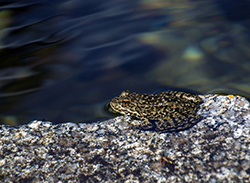
It does not take a leap of faith to believe that CDFW scientists have gained the upper hand in bolstering the population of yellow-legged frogs in the High Sierra.
Over the past three decades, Sierra Nevada yellow-legged frogs have become imperiled in California due to the two-pronged impact of introduced (non-native) trout and chytridiomycosis, a disease that is affecting amphibians worldwide.
Past introduction of non-native fish, including rainbow trout and golden trout, to benefit sport fishing in the High Sierra took a heavy toll on the species. High-elevation lakes where these frogs once flourished were largely fishless until fish stocking came into vogue. As the years passed, scientists determined that these introduced fish were depopulating the frogs by competing for food sources (primarily insects) and by predation (trout ate both adult frogs and their tadpoles). Chytridiomycosis, which affects many frog species, also impaired the ability of the Sierra Nevada yellow-legged frog’s skin to exchange vital nutrients, which often leads to death.
As a result, Sierra Nevada yellow-legged frogs are believed to have vanished from approximately 92 percent of their historical habitat, and halting and reversing that decline has become an important goal of CDFW, as well as other state and federal entities.
“This is an animal that only lives in the Sierra Nevada,” said Sarah Mussulman, a CDFW senior environmental scientist. “It is one of our unique California species that lives in high-elevation areas, and as an amphibian it serves as an important link between the terrestrial and aquatic ecosystems. This link is especially critical in the low nutrient, granitic basins of the High Sierra, where frogs and tadpoles consume insects and algae and are themselves consumed by a variety of snakes, birds and mammals.”
CDFW recently completed two projects as part of its ongoing efforts to reverse the population decline of Sierra Nevada yellow-legged frogs.
The efforts took place at two sites: Highland Lake and Clyde Lake, located approximately seven miles apart on the Rubicon River in the Desolation Wilderness area of El Dorado County. The projects were completed with federal grant funds earmarked for the recovery of endangered and threatened species (the species is listed as threatened by the State of California and as endangered by the U.S. Fish and Wildlife Service).
Highland Lake, along with its outlet, an unnamed stream, and two small adjacent ponds, supported a small population of rainbow trout when the project began in 2012. Trout abundance had declined in the absence of stocking in recent years but sufficient natural reproduction occurred in the inlet to Highland Lake to sustain the population. CDFW began using gill nets to remove rainbow trout -- the descendants of fish planted in the lake by CDFW from 1935 to 2000 -- in 2012, in partnership with Eldorado National Forest personnel.
During a frog-monitoring survey at Highland Lake in 2016, approximately 800 adult frogs were observed, as compared to a 2003 survey in which only a few tadpoles were observed. Because the frogs have consistently survived in this area despite the presence of chytridiomycosis, scientists believe they have a good chance at persisting in the area for a long time.
“Highland really had a population explosion over the past five years and can be counted as one of the most successful projects of this type ever undertaken,” Mussulman said.
The project at Clyde Lake was smaller and had somewhat different factors.
Golden trout, which frequently have the same negative impacts on Sierra Nevada yellow-legged frogs as rainbow trout, including predation and competition for food sources, were planted by CDFW at Clyde Lake from 1932 through 2000.
Once stocking was halted, the golden trout proved less resilient then the rainbow trout at Highland Lake, due to habitat factors.
“Clyde Lake sits in a north-facing granite bowl bordered by 1,000-foot cliffs, and no flowing streams enter the lake,” explained Mussulman. “There was no spawning habitat, which is likely why golden trout did not persist there after stocking was halted.”
The stream flowing out of Clyde Lake and four nearby ponds did support a small population of golden trout after plants were halted. The fish in the stream and ponds, which are self-sustaining populations, are precluded from moving from the stream into Clyde Lake by a fabricated dam. In 2013, frogs and a few tadpoles were observed in the stream alongside fish, and CDFW began removing the fish from the stream with gill nets to provide additional habitat for the frogs.
Nine years of monitoring data collected by CDFW scientists indicate that the area’s Sierra Nevada yellow-legged frog population, while small, is slowly increasing. Surveyors observed more than 120 frogs in 2016, compared to a low of six observed in 2005. Moreover, in 2016, for the first time, dozens of tadpoles were observed in the newly fish-free lower reaches of the stream.
“It is great to see these populations recovering,” Mussulman said. “It is a great privilege doing this work that helps keep these frogs on the landscape.”
CDFW photos: Highland Lake in the Desolation Wilderness, and a Sierra Nevada yellow-legged frog